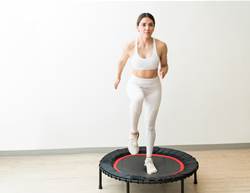I like paper diaries, real books and analogue watches. I think that most of us are addicted to our phones and the last thing I need is another device to charge. So, when I was kindly given the opportunity to try a Google Pixel Watch 2, I was more than a little bit sceptical.
Around 24% of Australians use fitness trackers and 23% have smart watches, reports The University of Sydney. Despite being a lo-fi person, it’s time I figure out why. Here are six features of the watch that may motivate you to have a healthier lifestyle.
1. A smart watch is a great excuse to leave your phone at home
As a smart watch, the Google Pixel 2 does everything you need, working with your Android phone (no, it's not compatible with an iPhone). You can receive and answer phone calls and messages. You can pay through Google Wallet. You can speak to your "Google Assistant" to set a timer, check your calendar or send messages.
I leave notifications on for quick trips out of the house, like for a quick walk or to pick up milk. This means I can leave my phone at home, knowing that I can pay for things and get important phone calls if needed. And not having access to my emails or social media via my phone in these instances, feels good for my brain.
2. Focus on the device as a fitness tracker
As much as I couldn’t live without my smartphone, I also know research shows it can interfere with my sleep, mental health and productivity. While a smart watch isn’t quite the same (no doom-scrolling), the last thing I want is pings and alerts attached to my own body.
However, it is easy enough to adjust your app notifications as you like them. The “do not disturb” and “sleep mode” buttons are also easy to access in the top swipe-down menu.
I’ve adjusted my notifications so that I’m primarily using the watch as a fitness tracker. At first, I wondered if the watch would actually tell me anything I didn’t already know. Had a bad night’s sleep? Well, my tiredness usually tells me that before a device. Heart rate? Not of much interest to me as a non-athlete with little risk of heart disease.
However, I found the step counter revealing. It made me realise exactly how much physical activity I fit in simply parenting two young kids. The classic goal of 10,000 steps? An absolute breeze.
There was even one day when I didn’t have time to squeeze in my usual exercise walk due to a long list of appointments and chores. That day, I did a whopping 20,000 steps. If not for the watch, I may have wondered why I was tired that evening, or felt guilty for not fitting in exercise. So, the fitness tracker was picking up my incidental exercise and the findings were encouraging. I was doing more exercise than I thought.
The watch really came into its own with the Fitbit app on my phone. The app goes into greater detail into everything you’re tracking, including:
- Your goal, for example steps, active zone minutes, calories or distance.
- Sleep
- Steps
- Heart rate
- Stress management score
Then the health elements you can manually enter like
- Food and water
- Menstrual health, like period apps My Calendar and Flo.
If you are the athletic type, there are more advanced features for you to track specific workouts, pace training and heart rate zones.
3. Track exercise intensity
With the Google Pixel Watch, you can track your exercise intensity with “active zone” minutes. You rack up these minutes by being moderately to very active for 10 minutes or more, based on heart rate zones.
The government recommends most adults do 2.5 to 5 hours of moderate intensity exercise or 1.25 to 2.5 hours of vigorous intensity exercise each week. So being able to track higher intensity exercise could motivate many people to up their game.
4. Get movement reminders
When I'm more sedentary than I should be, sitting in front of a computer or binge watching the latest show, the watch sends me regular reminders to move. This is genuinely helpful.
We all know the risks of sitting too much and moving about once an hour can make a difference to your overall health. Once the watch started prompting me, I was more likely to get up and get myself a glass of water or to take a quick “exercise snack” break.
5. Access exercise and meditation classes
The watch is linked with Fitbit and comes with six months of Fitbit Premium membership. This means you can access a wide range of instructional video and audio recordings on your phone, from strength training and dance cardio through to yoga and meditations. Some of these are short, sharp workouts, perfect for when you’re low on time but need to squeeze in some movement at home.
6. Test and track your heart rhythm
This is the part that really blows my mind. Atrial fibrillation is a common type of heart arrhythmia where the heart beats in an abnormal and irregular rhythm. The condition increases the risk of blood clots, stroke, heart failure and other heart-related complications, says the Mayo Clinic.
This condition is detected with an electrocardiogram, or ECG, usually in a hospital or doctor’s clinic. You can now do a simpler ECG using certain fitness trackers, including the Google Pixel Watch 2. And while it’s not as accurate as a medical ECG, it’s still incredible that you can do this from your watch, at home. The watch can also send you notifications if it detects an irregular heart rhythm while you’re still or sleeping.
The verdict?
The Google Pixel Watch 2 is an attractive device with lots of potential for your health.
On the fitness front, is there any evidence fitness trackers are actually motivating us? Yes, according to the University of South Australia. Researchers reviewed almost 400 studies on fitness trackers across the world. They found fitness trackers encourage us to walk up to 40 minutes more each day (approximately 1,800 more steps), resulting in an average 1kg weight loss over five months. They can be very effective healthy habit builders.
I’m not convinced a smart watch is good for your mental health or attention span. But if you’re likely to get distracted or stressed by notifications or tracking your every move, then it’s easy enough to customise when and how you interact with the watch.
What about other fitness trackers?
Best for iPhones: Apple Watch
Prevention US reviewed this one and says: “The Apple Watch’s battery life (18 hours) holds it back from being a truly great fitness tracker, but it excels as a smartwatch with some pretty impressive features.”
Best for fewer distractions: Whoop Strap 4.0
If you want to track your health and fitness and are serious about not having any screens or distractions on your body, Whoop is a great option.
Prevention US reviewed this one and says “Most casual fitness fans won’t need its incredible amount of data, but those who want to fine-tune workouts and precisely track progress will love it. It monitors blood oxygen levels, skin temperature readings, sleep, and heart rate metrics.”









